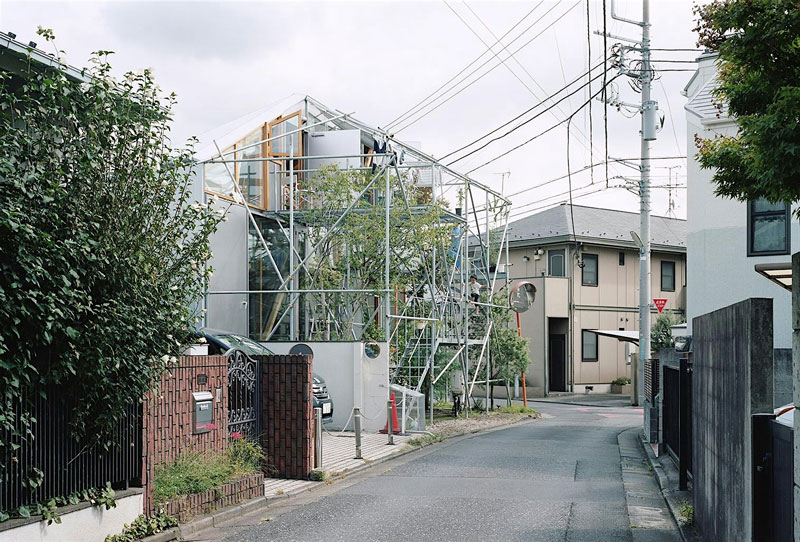
Image: Suzuko Yamada Architects, Daita2019 House. Photo by Yrika Kono.
The Essence of Architecture: Material Conversations
- 18 January 2025
- The Hall and the Library, Japan House London, 101-111 Kensington High Street, London, W8 5SA
- https://www.japanhouselondon.uk/whats-on/the-essence-of-architecture-material-conversations/
- +44 (0)20 7932 7100
- info@japanhouselondon.uk
- Tweet
Join us at Japan House London for an afternoon of insightful presentations and discussions on how innovative design practices are reshaping our understanding of the built environment.
In the context of architecture, ‘distillation’ refers to refining ideas, materials, and processes to their essence. Held in conjunction with the exhibition Distillation of Architecture: 家具 opening on 17 January at the Architectural Association School of Architecture (AA), this symposium explores the work and practices of innovative Japanese architects and material artists who are working collaboratively to reimagine furniture and living spaces through the lens of ‘architectural distillation’.
Four presenting pairs will each be joined in conversation by a London-based practitioner, inviting attendees to a dynamic exchange of ideas.
Programme:
14:00: Presentations and Discussions – First Session
Opening Comments by Egashira Shin (AA) and Maeda Soji (Maeda Corporation)
Nagasaka Jo (Schemata Architects) + Sagara Ikuya (Kusakanmuri Workshop)
Tsuneyama Mio (Studio MNM) + Bansho Textile
15:30-15:45: Break
15:45: Presentations and Discussions – Second Session
Suzuko Yamada Architects + Murakami Yūki
Tsubame Architects + Hidakuma Studio
Closing Remarks by Dr. Ingrid Schroder (AA)
17:15-18:45: Drinks reception
(London-based practitioners to be announced at a later date)
*Please note that filming and / or photography may take place at this event. Photos and footage of the event may then be used to promote Japan House London, helping more people to discover what we offer. If you have any concerns, please contact us online or contact a member of the team on site.
About the Facilitators:
Egashira Shin is an architect, artist, educator and PhD candidate. He worked in Tokyo, Beijing and New York before coming to London to study at the AA. From 1990 he has taught at the AA and has run a unit since 1996. He has been an artist in residence at Camden Arts Centre and Bennington College. He has also run the Koshirakura Landscape Workshop in Niigata and the AA Maeda Workshop in Tokyo, London and Hooke Park, and is a visiting professor at Tokyo University of Fine Arts.
Ingrid Schroder is Director of the Architectural Association.
About the Speakers:
Nagasaka Jo established Schemata Architects after graduating from Tokyo University of the Arts in 1998, and now has his design office in Kitasando, Tokyo. The scale of his work ranges from furniture and architecture to urban landscape. Throughout his work, Nagasaka explores new perspectives on materials and design, considering concepts including subtraction, misuse, invisible development and semi-architecture to articulate an original architectural vision.
Sagara Ikuya is a thatch craftsman and Director of Kusakanmuri Ltd. He is based in Ougo-chō, the northern ward of Kobe City, in Hyogo Prefecture. Sagara experiments with thatch to bring the material into wider contemporary use, situating himself between the sky and the earth, the urban and the rural, the past and the present, farmers and craftsmen, and Japan and beyond. He received the Kobe City Award for Cultural Contribution in 2015, several awards of excellence in Japan, and was a Loewe Craft Prize finalist in 2024.
Tsuneyama Mio is a Tokyo-based architect and founder of Studio MNM who specialises in the intersection of contemporary cities and ecosystems. Her work uses resources in the city to improve habitability and create sustainable, multispecies networks. She was awarded a Special Mention at the 15th Venice Architecture Biennale for the Japanese Pavilion and teaches at institutions including Tokyo University of Science, École Polytechnique Fédérale de Lausanne and Columbia University.
Madeleine Kessler is a London-based architect, curator and urbanist dedicated to designing joyful people-centred places that contribute positively to our planet. She has led experimental projects that explore the social aspects of spatial life, including
co-curation of the British Pavilion at the 17th Venice Architecture Biennale, the Gingerbread City Masterplan in New York City and Filling the Void in Karlsruhe. She is a recipient of the RIBA Rising Star Award and was listed in the Architects’ Journal ’s 40 under 40.
Yamada Suzuko is a Tokyo native and a graduate of the University of California, Berkeley and Tokyo Art University. She set up her independent studio in 2013 in Tokyo, having previously worked at Sou Fujimoto Architects. Yamada now teaches at Kyoto University and Tokyo University of Science. In practice, she explores a distinctly experimental architecture and her work was recognised in the Architectural Design Association of Nippon and Japan’s Under 35 Architects exhibition in 2020.
While studying at university, Murakami Yūki developed an innovative new material, ‘banana leather’ made from banana peel. Since graduating he has continued to experiment with creating new materials, including one using coffee grounds and milk called ‘Café au Lait Base’ and one using food waste called ‘Edible Leather’. By demonstrating the potential of waste products with these new materials, his work intends to provoke people to shift their thinking towards a world where we move past the concept of ‘rubbish’.
Tsubame Architects is an architecture practice led by Sando Takuto, Chiba Motoo and Saikawa Himari. The practice features two divisions: a ‘DESIGN’ arm focusing on architecture and construction, and a ‘LAB’ arm that operates as a research think-tank. By working on projects in rotation between these two divisions, the practice is able to make broader proposals for architecture projects and how to use buildings after completion.
Hidakuma, shortened from ‘Hida no mori de kuma wa odoru’ (meaning Bears Dance in the Forest of Hida), is a studio based in Hida City, Gifu Prefecture. The studio’s core mission is to promote the value of hardwood forests, reflected in their motto: ‘forests are not lumber’. By studying cultural practices and timber distribution centred around the forest, the studio attempts to broaden the variety of materials derived from the forest that can be used in modern production, and to connect these overlooked resources with our modern ways of living. The studio works as three teams, each with a different focus; through the collaboration of these, the studio’s activities enhance forest accessibility and develop sustainable and cyclical architecture.
Booking Essential | Admission Free
